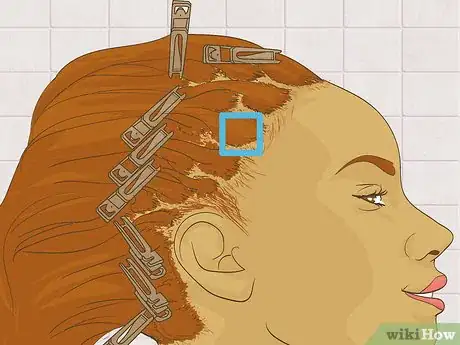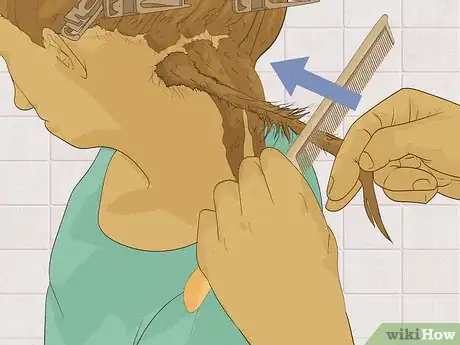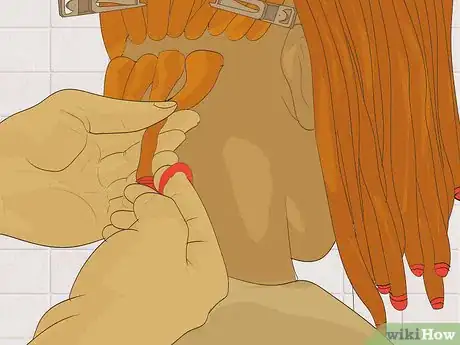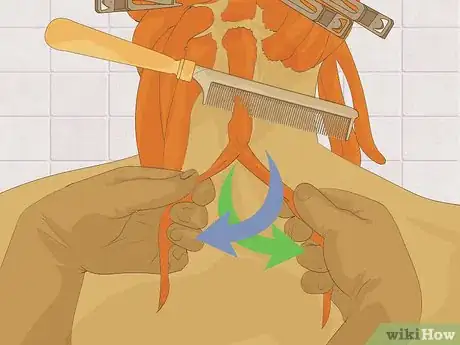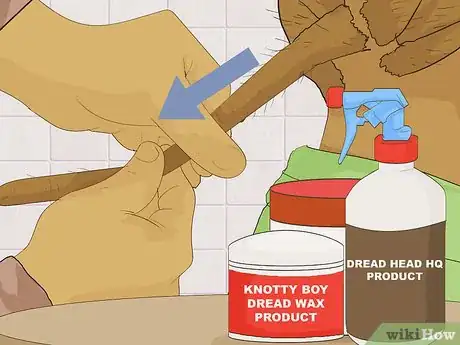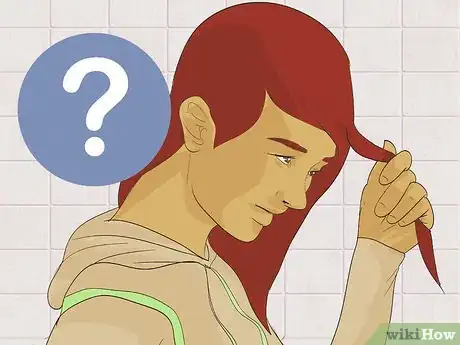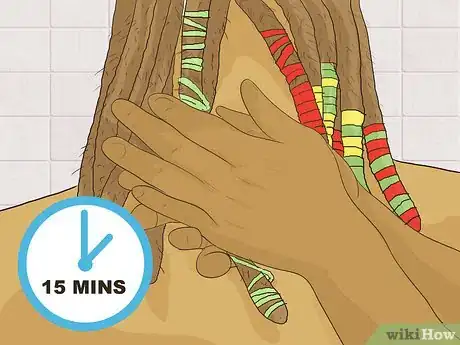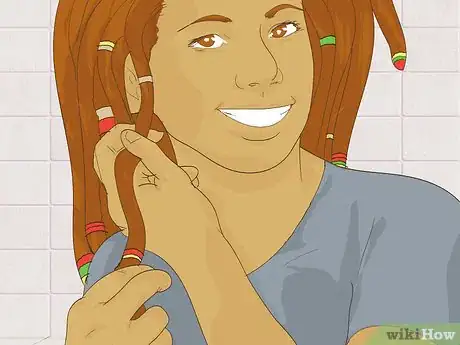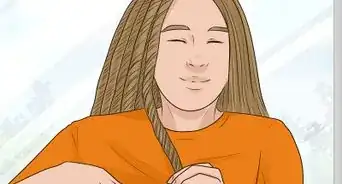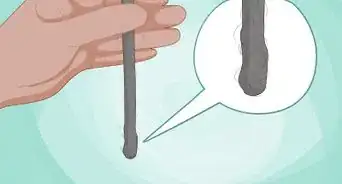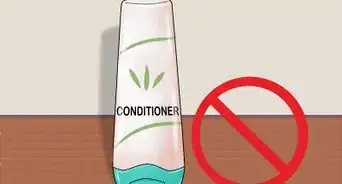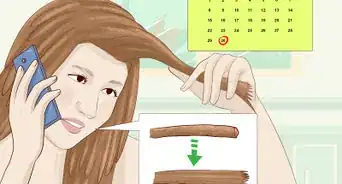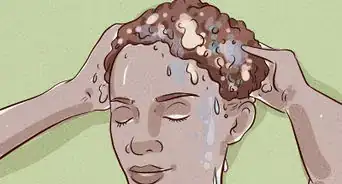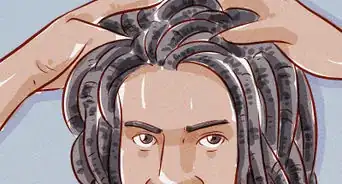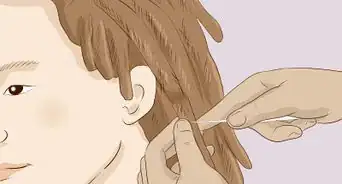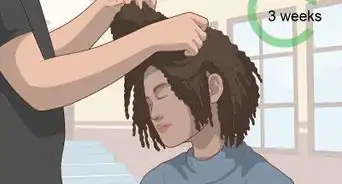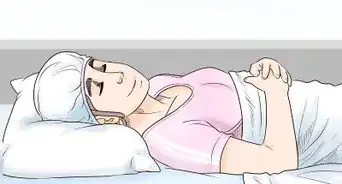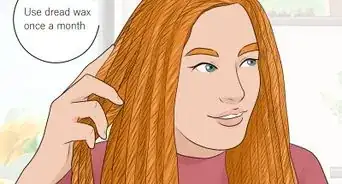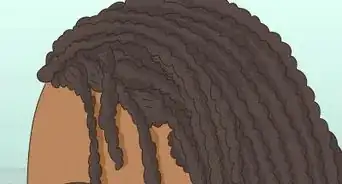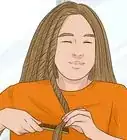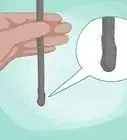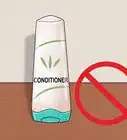X
This article was co-authored by Ashley Adams. Ashley Adams is a Licensed Cosmetologist and Hair Stylist in Illinois. She completed her Cosmetology education at John Amico School of Hair Design in 2016.
This article has been viewed 57,566 times.
Dreadlocks are ropes of hair that can be formed by several different methods, including backcombing, twisting, and using a wool sweater. Almost every hair type can be dreaded, though textured hair takes best to it. Long hair is especially easy to begin dreadlocks. All you need to begin the dreading process is a comb, wax, rubber bands, and some time set aside to form the locks.
Steps
Method 1
Method 1 of 3:
Backcombing for Dreads
-
1Section your hair into squares. Begin with damp hair. Smaller sections make smaller dreads, and wider squares make larger dreads. One or two inch sections are ideal. Continue until all of your hair has been sectioned.[1]
- You can temporarily secure each section with a rubber band.
- Keep a spray bottle near you to dampen hair again when it dries.
-
2Use a dread comb. Start combing near the scalp—less than an inch away. Comb in the direction of the scalp. Roll the hair you are combing between your fingers to help the process. Comb repeatedly until the hair starts to pack up near the roots.[2]
- If you have textured hair, use the comb to twist your hair, not your fingers.
- If you have naturally straight hair, start by backcombing your hair. Then begin to twist with your fingers.
- Don’t use a weak dread comb that will snap and break easily. Look for one that has bristles that are strong and close together.[3]
- You can purchase a dread comb at many beauty supply stores and Walmart.
Advertisement -
3Continue backcombing. Do this until you reach the ends of your hair. Make sure to work slowly. Try to make the dreads as tight as possible as you comb.[4]
-
4Secure dreads with a rubber band. Once you are finished combing, secure the ends of your hair with a rubber band. Small rubber bands are best to use. You can also secure the roots of your dreads. Remove the rubber bands once the dreads start to mature.[5]
- If you have coarse, textured hair, then you do not need to use a rubber band.
- You can remove the rubber bands when the locks stay in shape on their own.
-
5Wax your dreads. Apply wax to each lock when are done using rubber bands. Make sure that the wax does not contain petroleum because it will cause unwanted buildup. The wax should help you maintain the shape of the locks and speed up the process.
- You can buy dread wax at many beauty supply stores and online.
Advertisement
Method 2
Method 2 of 3:
Twisting for Dreads
-
1Section your hair. Divide your hair into even sections. Section your hair according to the size you’d like the lock to be. Begin to section your hair into squares.[6]
- One to two inches (2 ½ to 5 cm) for each square is usually a good size.
- If you wish, you can secure each section with a rubber band when you are finished sectioning. However, this is not necessary and can be more time consuming.
-
2Twist each section. Using a comb, begin to twist each section clockwise. Snag and twist the hairs once you reach the end of the section. Continue this process until you have twisted every section of your hair.[7]
-
3Use a dread wax. Wax each section to hold the twists. You can do this when you are completely finished twisting, but it is better to do it as you finish each section. Use a thicker wax that does not contain petroleum to begin with.[8]
- You can use rubber bands at the roots and ends for the first couple of weeks.
- Thicker wax is best to begin with because it holds the shape of the locks better than a thinner wax.
-
4Maintain the new dreads. Twist your hair into shape regularly to help the locks form and keep the shape. You can use a thinner wax once the dreadlocks begin to mature. A thinner wax is used more for fragrance and shine than holding the locks into place.[9]
Advertisement
Method 3
Method 3 of 3:
Dreading with a Wool Sweater
-
1Consider the negatives. This is an effective way to dread your hair, but it also comes with its downsides. Because you are rubbing and knotting your hair so much in one session, it can really hurt. It is also more permanent than other methods, so you will have to cut your hair if you don’t like how it turns out.
-
2Rub your hair with wool. You can use a wool sweater or hat. Rub the wool hat in circles on your hair. Do this for about fifteen minutes. Knots should begin to form.
-
3Rip the knots apart. Rip your knotted hair apart and into sections. Separate the sections to form individual dreads. Do not use anything to secure your hair yet.[10]
-
4Continue to rub your hair. After you have sectioned your hair, continue to rub with a wool sweater for about fifteen more minutes. Repeat until all of your hair becomes knotted. Tuck loose hair into the dread that is closest. Use dread wax to seal the locks. [11]
- You can use rubber bands at the root and ends of the locks to help them stay in shape until they mature.
Advertisement
Expert Q&A
-
QuestionHow long does it take for your hair to dread?
 Laura MartinLaura Martin is a Licensed Cosmetologist in Georgia. She has been a hair stylist since 2007 and a cosmetology teacher since 2013.
Laura MartinLaura Martin is a Licensed Cosmetologist in Georgia. She has been a hair stylist since 2007 and a cosmetology teacher since 2013.
Licensed Cosmetologist To get solid locks can take up to a year. Usually, the shape will start to feel stable and the dreads feel smoother around 6 weeks.
To get solid locks can take up to a year. Usually, the shape will start to feel stable and the dreads feel smoother around 6 weeks. -
QuestionHow long does your hair have to be to get dreadlocks?
 Laura MartinLaura Martin is a Licensed Cosmetologist in Georgia. She has been a hair stylist since 2007 and a cosmetology teacher since 2013.
Laura MartinLaura Martin is a Licensed Cosmetologist in Georgia. She has been a hair stylist since 2007 and a cosmetology teacher since 2013.
Licensed Cosmetologist A minimum of 3 inches is recommended, but it is easier with longer hair, so 5-6 inches is ideal.
A minimum of 3 inches is recommended, but it is easier with longer hair, so 5-6 inches is ideal. -
QuestionHow long does it take for your twist to lock?
 Laura MartinLaura Martin is a Licensed Cosmetologist in Georgia. She has been a hair stylist since 2007 and a cosmetology teacher since 2013.
Laura MartinLaura Martin is a Licensed Cosmetologist in Georgia. She has been a hair stylist since 2007 and a cosmetology teacher since 2013.
Licensed Cosmetologist It usually takes about six weeks for the dreads to begin to lock. A fully locked, completely smooth dread can take longer, especially on straight or wavy hair.
It usually takes about six weeks for the dreads to begin to lock. A fully locked, completely smooth dread can take longer, especially on straight or wavy hair.
Advertisement
Warnings
- Do not use beeswax or petroleum jelly on your hair. The buildup of these products attracts dirt and lint.⧼thumbs_response⧽
- Avoid twisting the the lock too tightly. This can weaken the base of the lock.⧼thumbs_response⧽
Advertisement
Things You’ll Need
- Rubber bands
- Dread comb
- Dread wax
- Wool sweater (for wool method)
References
- ↑ http://www.dreadlocks.com/methods.html
- ↑ http://www.dreadlocks.com/methods.html
- ↑ https://www.dreadheadhq.com/pages/what-you-need-to-start-dreadlocks
- ↑ http://www.dreadlocks.com/methods.html
- ↑ http://www.dreadlocks.com/methods.html
- ↑ http://www.dreadlocks.com/methods.html
- ↑ http://www.dreadlocks.com/methods.html
- ↑ http://www.dreadlocks.com/methods.html
- ↑ http://www.dreadlocks.com/methods.html
About This Article
Advertisement
